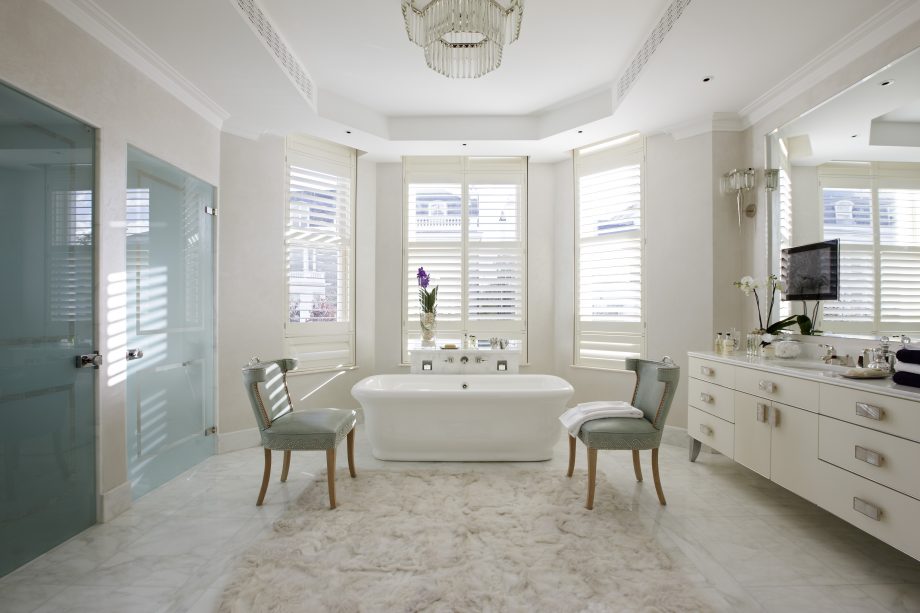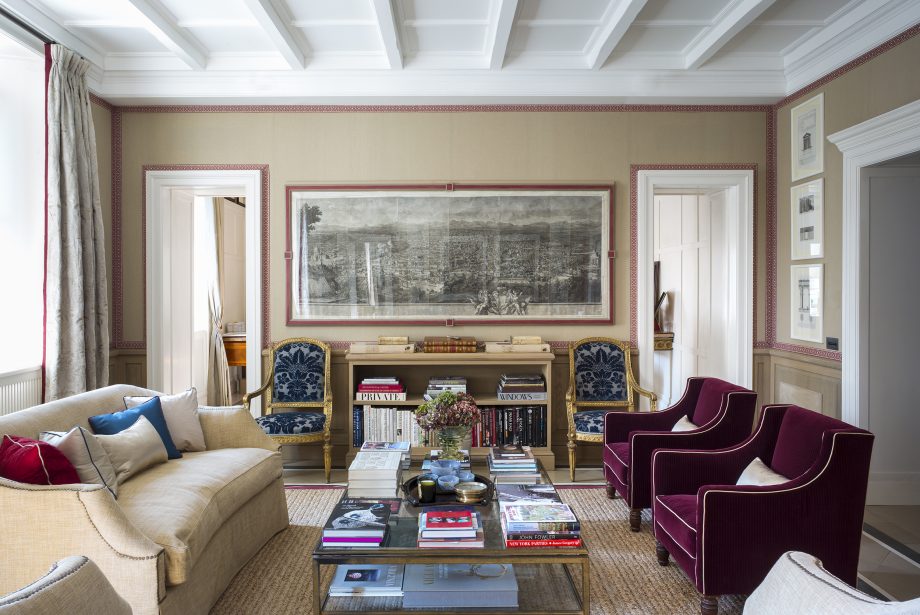In the half century since Nina Campbell set up her decorating business, she has accumulated a depth and breadth of interiors knowledge that is as practical as it is inspiring. Here, she shares the 50 most valuable lessons from a stellar career.
There are few hard-and-fast rules of decorating, but simply following your instincts can be both time consuming and expensive.
One rule is that comfort and practicality are the foundation of every successful room; after a lifetime of projects that have included everything from decorating Annabel’s and a box at Ascot to English country houses and apartments in Manhattan, I’ve learnt that decorating relies on anticipating the needs of clients and their guests. No detail is ever too small to be overlooked and, when they have all been properly considered and planned, the whole will be infinitely greater than a sum of the parts.
What the past 50 years has also taught me is that, as well as being comfortable, the best rooms are also fun, interesting and memorable places to be. Get that right and you’ll never want to leave.
A few eternal truths
Rooms should be as comfortable as they are stylish
John Fowler told me never to plan a room completely. Sort the bones and then walk into the room and it will tell you what it wants
The excitement in a room is when it contains a combination of things: some new, some that have been in the family for ages and some unusual finds
Wit is important: have something in a room that is a bit quirky
You can get away more easily with a bad design in a good colour than a good design in a bad colour
Scale is vital; avoid the middle road and remember that contrast is king
Don’t coordinate things too much — you always need a spark of something unexpected to make it look as if you haven’t tried too hard
Shop around; it may be more difficult than buying everything from the same place, but it’s much more interesting and satisfying
A room needs time to settle into itself and it often looks better a few weeks after it’s been finished, so don’t pass judgement on your efforts too soon
Husbands can come and go, but whatever you do, hang on to your curtain-maker

Sezincote’s drawing room with its curtains recreated by John Fowler in the 1960s
Sitting comfortably
Be sure to choose a piece of furniture that suits everyone —you don’t want older guests to sink into a deep armchair (together with the dog)
If you’ve fallen for a fabric you can’t afford, have it made up into cushions rather than curtains or a sofa
Think of conversational possibilities: you never want anyone to be stuck on a chair by themselves
Club fenders are wonderful, but, in my view, they are only suited to English fireplaces. They don’t tend to work on Continental styles

Fireplace with fender in cosy library painted in Calke Green by Farrow and Ball. The Sofa is by David Hicks.
Remember to tint your ceiling to a colour — a dead-white ceiling will look grey
Don’t be afraid of strong colours. If considering Hermès orange, for example, remember you’re going to cover it with paintings
Have occasional chairs that can create a triangular arrangement
Always consider the possibilities of corner seating; it offers the ideal set-up for conversations or games of backgammon
A beautiful bathroom
For those with hectic lives (particularly those with children) a beautiful, calm and spacious bathroom is pure luxury
Try to have an armchair in a bathroom; bath time is a good opportunity for a chat and a glass of Champagne

The bathroom at Upton House, photographed in the summer of 1936. ©Country Life
To avoid accumulating things in bathrooms, steer clear of too much storage. A surface next to the basin will keep paraphernalia to a minimum
Carpets are fine in bathrooms as long as they only have a bath or basin; those with a shower need stone or ceramic floors
If a bathroom is small, try to have some elements with legs, such as the bath or basin. It will help to create the impression of space
Never put the loo directly in front of the door — hide it around the corner
Bedded bliss
The most important thing is to keep bedrooms calm with a walk-in closet, so that clothes are kept out of the way
To avoid bedroom joinery looking too much like a fitted kitchen, replace the central panels of wardrobes with chicken wire over pleated fabric
In small bedrooms, if there isn’t room for a bedside table, consider building a niche into any adjacent joinery
Lightweight piqué covers are particularly useful on beds if you have dogs as they can be easily thrown into the washing machine (the covers, rather than the dogs, that is). Antique tablecloths make wonderful covers
Put baffles on central ceiling pendants so you’re not lying in bed looking up at the glare of a naked lightbulb
Much as I love blinds, there are some occasions when a bedroom calls for curtains. There’s nothing more comforting than shutting the world out at the end of a long day
Always have a bookcase in a bedroom. There’s something deeply pleasing (and soporific) about being surrounded by books

Chettle House, Dorset. The bookcases and doorcases in the drawing room were designed by Hugh Petter as part of the recent redecoration. Photograph: Paul Highnam/Country Life Picture Library
In my view, bedrooms — rather than sitting rooms — are the ideal place for family photographs and watercolours
Hang wallpaper on the inside of wardrobes so that they look pretty when you open the doors
I don’t have any rules about colours for bedrooms; I once stayed with a friend who had lined the walls of their spare room in a deep burgundy cloth. I have never slept better in my life; it was like being back in the womb
Bedroom lighting should be multi-layered: you need lights to read by, lights to wash by and you should be able to control them from the bed
I have to have a television in my bedroom and don’t see any reason to disguise it
Be a host with the most
Make sure to have nice hangers in cupboards; beware of dry cleaners’ hangers creeping into the mix. I like to have soft, upholstered ones for dresses and shirts and wooden ones for everything else
Keep a lavender sachet on the pillows of your guest bedroom. They can be a great way to induce sleep
Display an up-to-date selection of good books
Spend a night in any spare bedrooms you have to make sure they’re comfortable for visitors
It’s no longer enough to leave a hairdryer in a drawer — keep a phone charger ready for use in the spare bedroom, too
A radio is always a good addition, especially for insomniacs
Fun with friends
Is there anything nicer than the sight of a heavily laden drinks tray with an ice bucket filled to the gunwales?
Dining rooms that are rarely full of people become sad and musty. Find another purpose for them, such as a billiard room
Antique plates were made to be used, although make sure you wash them yourself rather than entrust the job to someone else
Linen sheets that have tears or have been damaged can be cut up and hemmed into napkins or dishcloths (glasses should always be dried using linen)
A thoughtfully laid table is a joy to behold; I have lots of china ready to create different table settings

Dining room at Beckside House. ©Paul Highnam for Country Life
I only serve Champagne and wine at parties; cocktails can get incredibly complicated when people arrive at the same time
Keep the hors d’oeuvres simple: cheese straws, served in glass ice pails with silver tops, go very quickly
I’m not keen on ordinary water tumblers — they remind me of boarding school. I love having a mix of different types and scour antique markets for them

Beautiful bathrooms: How to design your lighting, draw the eye and make the most of your space
Bathrooms are typically the smallest room in the house - interior designer Joanna Wood shares her top tips and tricks

Six top tips on how to ‘upcycle’ old homeware, creating stunning original pieces and safeguarding the environment
Sustainable interior designer, upcycler and self-proclaimed ‘warrior on waste’ Lynne Lambourne offers her expert tips on how to upcycle items found in your home

Country Life’s 10 best interiors articles of 2020, from baths in bedrooms to colour schemes for Georgian country houses
Enjoy our list of the most-viewed interior design and decoration articles from Country Life in the last 12 months.

The Country Life Top 100 architects, interior designers, craftsmen, builders and garden designers in Britain
It's now six years since the original Country Life Top 100 was published, but the aim hasn't changed: we name




